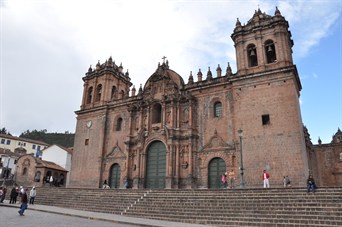The mestizo style of Andean Baroque
 Andean Baroque, also known as estilo mestizo, became widespread in the Viceroyalty of Peru in the second half of the seventeenth century and the end of the eighteenth century. It is located mainly between the city of Arequipa in the south of Peru and Lake Titicaca, from where it spread over the lands of the plateau. The most obvious example of Andean Baroque art finds himself in religious architecture, to which indigenous artists gave a particular character, as happened in the Baroque of New Spain. Even the paintings of the period made by indigenous artists show religious figures decorated with traditional Andean elements, particularly in their physical traits and clothing.
Andean Baroque, also known as estilo mestizo, became widespread in the Viceroyalty of Peru in the second half of the seventeenth century and the end of the eighteenth century. It is located mainly between the city of Arequipa in the south of Peru and Lake Titicaca, from where it spread over the lands of the plateau. The most obvious example of Andean Baroque art finds himself in religious architecture, to which indigenous artists gave a particular character, as happened in the Baroque of New Spain. Even the paintings of the period made by indigenous artists show religious figures decorated with traditional Andean elements, particularly in their physical traits and clothing.
In the seventeenth century, the dense cultural relations between Italy and Spain, marked by the influence of Caravaggio, led the Spanish artistic world to abandon the tradition of the Renaissance and Mannerist aesthetics. In Valencia, as in Seville, several artists began to superimpose natural elements to Mannerist structure and Diego Velázquez and Francisco de Zurbarán were formed under this influence. The arrival of several paintings of the latter in the Viceroyalty of Peru, as well as the collection of prints commissioned by Spain to various Flemish workshops brought the Baroque to South America. Between 1600 and 1630 the tendency developed to give a homogeneous formal language to the various artistic representations that could contain themes ranging from Greco-Latin culture to prehispanic symbols, to all the motifs Christians introduced to the Americas. In this way, indigenous themes were included alongside conventions which came from the Iberian Peninsula, with Gothic and MudéjarMudéjar art became widespread in the Iberian peninsula after the end of Muslim rule in al-Andalus. It consisted in the incorporation of elements of Arabian-inspired style in the new Christian. The most famous example of Mudéjar art is the Alcázar of Seville. reminiscences and elements from Italian and Flemish art.
One of the main characteristics of American and Andean Baroque is the importance acquired by architecture. This was due to the need for churches to accommodate the recently Christianized populations. The originality of the Andean Baroque style is also in decoration, whose main themes inquired to the flora and fauna of tropical motifs such as sirens and Mannerist forms, a pre-Renaissance Christian elements. The sirens, among other things, although an element of classical antiquity, reminiscent of the indigenous tradition of women-fish present in some founding myths. (foto: the cathedral of Cuzco, a typical example of estilo mestizo)
